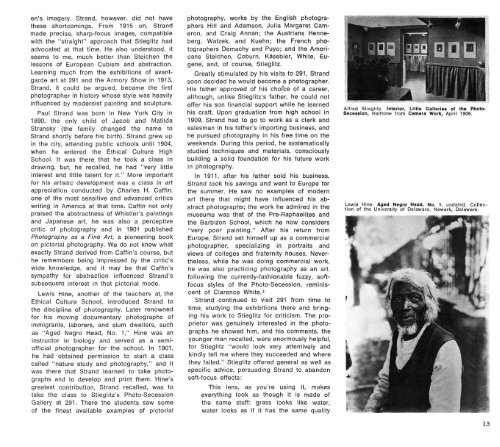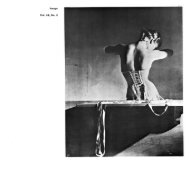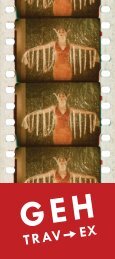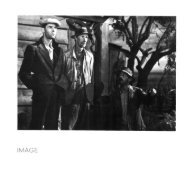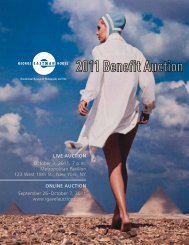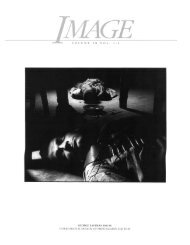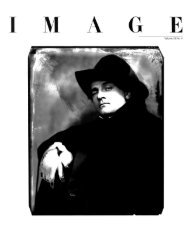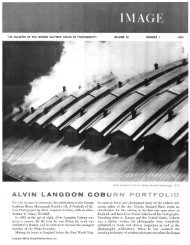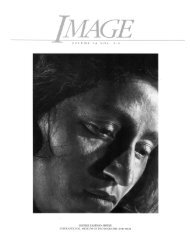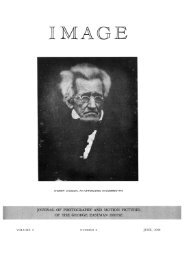Untitled - Issues of Image Magazine - George Eastman House
Untitled - Issues of Image Magazine - George Eastman House
Untitled - Issues of Image Magazine - George Eastman House
Create successful ePaper yourself
Turn your PDF publications into a flip-book with our unique Google optimized e-Paper software.
en's imagery. Strand, however, did not have<br />
these shortcomings. From 1915 on, Strand<br />
made precise, sharp-focus images, compatible<br />
with the "straight" approach that Stieglitz had<br />
advocated at that time. He also understood, it<br />
seems to me, much better than Steichen the<br />
lessons <strong>of</strong> European Cubism and abstraction.<br />
Learning much from the exhibitions <strong>of</strong> avantgarde<br />
art at 291 and the Armory Show in 1913,<br />
Strand, it could be argued, became the first<br />
photographer in history whose style was heavily<br />
influenced by modernist painting and sculpture.<br />
Paul Strand was born in New York City in<br />
1890, the only child <strong>of</strong> Jacob and Matilda<br />
Stransky (the family changed the name to<br />
Strand shortly before his birth). Strand grew up<br />
in the city, attending public schools until 1904,<br />
when he entered the Ethical Culture High<br />
School. It was there that he took a class in<br />
drawing, but, he recalled, he had "very little<br />
interest and little talent for it." More important<br />
for his artistic development was a class in art<br />
appreciation conducted by Charles H. Caffin,<br />
one <strong>of</strong> the most sensitive and advanced critics<br />
writing in America at that time. Caffin not only<br />
praised the abstractness <strong>of</strong> Whistler's paintings<br />
and Japanese art, he was also a perceptive<br />
critic <strong>of</strong> photography and in 1901 published<br />
Photography as a Fine Art, a pioneering book<br />
on pictorial photography. We do not know what<br />
exactly Strand derived from Caffin's course, but<br />
he remembers being impressed by the critic's<br />
wide knowledge, and it may be that Caffin's<br />
sympathy for abstraction influenced Strand's<br />
subsequent interest in that pictorial mode.<br />
Lewis Hine, another <strong>of</strong> the teachers at, the<br />
Ethical Culture School, introduced Strand to<br />
the discipline <strong>of</strong> photography. Later renowned<br />
for his moving documentary photographs <strong>of</strong><br />
immigrants, laborers, and slum dwellers, such<br />
as "Aged Negro Head, No. 1," Hine was an<br />
instructor in biology and served as a semi<strong>of</strong>ficial<br />
photographer for the school. In 1901,<br />
he had obtained permission to start a class<br />
called "nature study and photography," and it<br />
was there that Strand learned to take photographs<br />
and to develop and print them. Hine's<br />
greatest contribution, Strand recalled, was to<br />
take the class to Stieglitz's Photo-Secession<br />
Gallery at 291. There the students saw some<br />
<strong>of</strong> the finest available examples <strong>of</strong> pictorial<br />
photography, works by the English photographers<br />
Hill and Adamson, Julia Margaret Cameron,<br />
and Craig Annan; the Austrians Henneberg,<br />
Watzek, and Kuehn; the French photographers<br />
Demachy and Puyo; and the Americans<br />
Steichen, Coburn, Kasebier, White, Eugene,<br />
and, <strong>of</strong> course, Stieglitz.<br />
Greatly stimulated by his visits to 291, Strand<br />
soon decided he would become a photographer.<br />
His father approved <strong>of</strong> his choice <strong>of</strong> a career,<br />
although, unlike Stieglitz's father, he could not<br />
<strong>of</strong>fer his son financial support while he learned<br />
his craft. Upon graduation from high school in<br />
1909, Strand had to go to work as a clerk and<br />
salesman in his father's importing business, and<br />
he pursued photography in his free time on the<br />
weekends. During this period, he systematically<br />
studied techniques and materials, consciously<br />
building a solid foundation for his future work<br />
in photography.<br />
In 1911, after his father sold his business,<br />
Strand took his savings and went to Europe for<br />
the summer. He saw no examples <strong>of</strong> modern<br />
art there that might have influenced his abstract<br />
photographs; the work he admired in the<br />
museums was that <strong>of</strong> the Pre-Raphaelites and<br />
the Barbizon School, which he now considers<br />
"very poor painting." After his return from<br />
Europe, Strand set himself up as a commercial<br />
photographer, specializing in portraits and<br />
views <strong>of</strong> colleges and fraternity houses. Nevertheless,<br />
while he was doing commercial work,<br />
he was also practicing photography as an art.<br />
following the currently-fashionable fuzzy, s<strong>of</strong>tfocus<br />
styles <strong>of</strong> the Photo-Secession, reminiscent<br />
<strong>of</strong> Clarence White. 3<br />
Strand continued to visit 291 from time to<br />
time, studying the exhibitions there and bringing<br />
his work to Stieglitz for criticism. The proprietor<br />
was genuinely interested in the photographs<br />
he showed him, and his comments, the<br />
younger man recalled, were enormously helpful,<br />
for Stieglitz "would look very attentively and<br />
kindly tell me where they succeeded and where<br />
they failed." Stieglitz <strong>of</strong>fered general as well as<br />
specific advice, persuading Strand to abandon<br />
s<strong>of</strong>t-focus effects:<br />
This lens, as you're using it, makes<br />
everything look as though it is made <strong>of</strong><br />
the same stuff: grass looks like water,<br />
water looks as if it has the same quality<br />
13


